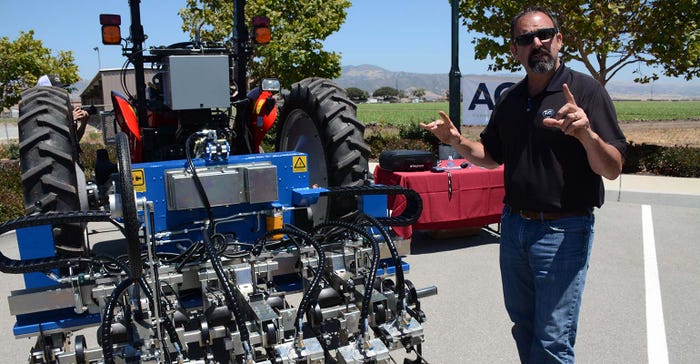
It was no accident that Forbes held its third annual AgTech Summit in farm-rich Salinas,Calif., just a few miles south of Silicon Valley last week.
The two worlds barely knew each other 10 years ago. But today, high-tech entrepreneurs and venture capitalists see agriculture as an industry ripe for data disruption. Investment in food and ag tech startups shot up to $4.6 billion in 2015, nearly doubling from 2014 levels, according to industry watchdog AgFunder.
“Most people don’t appreciate this, but agriculture has been in the forefront of technology for thousands of years,” says Steve Forbes, who spoke to the group of 600 farmers and entrepreneurs gathered in Salinas. “Ag tech is the future in terms of feeding billions of people today and billions tomorrow. We have to get the word out that ag is the most technologically innovative field in the world.”
Much of the innovation is focused on ag’s biggest problems, like water scarcity and labor shortages. Nowhere are those issues more pertinent than here in California’s Central Valley. California farmers grow two-thirds of the nation’s fruits and nuts, and one third of the nation’s vegetables. And more and more, they’re doing it with scarce resources.
The Forbes meeting was a forum that would make Buck Rogers’ head spin: talk of robots, water sensors, autonomous vehicles, and drones that could do precision bombing of beneficial insects to ward off infestations. It’s as if the geekheads on the left coast, along with some enterprising European companies, are taking up where traditional engineers of the Midwest left off.
Consider the Robovator, a ‘vision-based’ hoeing machine to take out weeds in row crops. This machine uses camera technology to identify the plants you want to save, and cuts everything else – including the weeds inside the row. It’s hydraulically powered and you can program how close you want the knives to cut in relation to the plants you save.
“This is a response to the growing labor problem,” says Daniel Butler, sales director. K.U.L.T., the Danish company building the product, set the price at $175,000. That may seem outlandish until you consider it costs nearly twice that much for a weeding crew, and the Robovator doesn’t need bathroom breaks. The company sold five units in its first week of production.
Closer to the Midwest – and especially pertinent now with Dicamba spray drift concerns – Irish-based MagGrow developed an ingenious way to cut spray drift by as much as 70% with a simple system using magnets and manifolds – much like an old-fashioned radiator.
“Studies show you can use 50% less pesticide and get the same efficacy,” says David Moore, chief technical officer. It works on any U.S. sprayer and any nozzle type, although finer droplets are better. MagGrow won Forbes’ sustainability award last year.
Water – or the lack of it – is an increasing problem for farmers everywhere, but nowhere was it more painful than in California during five years of merciless drought. Several companies are looking for ways to make water management more efficient, including CropX, a software-sensor product developed in Israel, where 60% of land is desert. It has two depths for water sensing. Farmers put the sensors in the ground, download the app and within minutes, start getting water readings.
“Customers call us and say they installed the sensor and the upper sensor is giving a reading and the bottom doesn’t seem to work, and we say, call a day later,” said Tomer Tzach, company CEO. “In 99% of the cases there’s also a reaction in the bottom sensor, which is to say water takes time to percolate. So growers who have been irrigating for decades were not aware of this.
“If you don’t measure you’ll never know how much you were over watering,” he added. “With sensors you don’t have to move sprinklers around, and you don’t lose quality from over or under irrigating. We see 10 to 20% increase revenue or reduction in expenses with CropX.”
Problem-solvers first
Forbes, a former presidential candidate and editor-in-chief at Forbes Media, noted how innovators were problem-solvers first. That’s how they came up with the McCormick reaper, the John Deere plow and hybrid seed. He praised Nobel Peace prize winner Norman Borlaug for his work in doubling wheat yields and saving millions of people from hunger. And today the focus on problem-solving continues, with things like data, robots and drones.
“There are challenges out there: EPA, water, labor, the battle against ignorance,” said Forbes. “There will always be resistance to change. Instead of extremists fighting you, they should be worshiping you. We would have nothing without food.
“Led by agriculture, each day in the world, 137,000 people leave dire poverty,” he added. “It doesn’t mean they are living in a nice suburb, but they are going away from absolute extreme where they may lose their lives. And if we remove obstacles they won’t be just rising above sustenance, but headed toward abundance.”
The opinions of the author are not necessarily those of Farm Futures or Penton Agriculture.
About the Author(s)
You May Also Like






